

Articles - Design for Manufacturing: Guidelines for Sheetmetal Fabrication. Perfect sheetmetal-fabrication designs—those that avoid engineering change orders (ECOs)—evolve only when designers take care to consider the capabilities of the equipment on the shop floor.
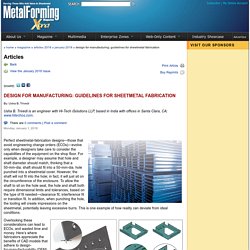
For example, a designer may assume that hole and shaft diameter should match, thinking that a 50-mm-dia. shaft should fit into a 50-mm-dia. hole punched into a sheetmetal cover. However, the shaft will not fit into the hole; in fact, it will just sit on the circumference of the enclosure. To allow the shaft to sit on the hole seat, the hole and shaft both require dimensional limits and tolerances, based on the type of fit needed—clearance fit, interference fit or transition fit. In addition, when punching the hole, the tooling will create impressions on the sheetmetal, potentially leaving excessive burrs. This is one example of how reality can deviate from ideal conditions. CAD Essentials for Fabrication at the Tipping Point of Industry 4.0. Sheet metal fabricators: Evaluating the odds of success with Industry 4.0 - Automation.
Industry 4.0 is driven by the interconnectivity of machines and intelligence derived by the aggregation of data obtained from manufacturing operations.
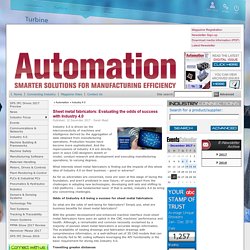
Production houses have become more sophisticated. And the repercussions of industry 4.0 are directly seen in ways CAD designers sketch or model; conduct research and development and executing manufacturing operations, to varying degrees. What interests sheet metal fabricators is finding out the impacts of this whole idea of Industry 4.0 on their business – good or adverse? As far as adversities are concerned, none are seen at this stage of laying the foundation, and aren’t predicted in near future; of course apart from the challenges in adopting new technologies, developing skill sets and shifting to CAD platforms – one fundamental need. If that is sorted, Industry 4.0 do bring any concerning challenges.
Odds of Industry 4.0 being a success for sheet metal fabricators So what are the odds of well-being for fabricators? Why CAD Models Need Standard Visibility for Precision Part Manufacturing - Digital Engineering. Precision part manufacturers face challenges that are related to the shop floor as well as the designs.
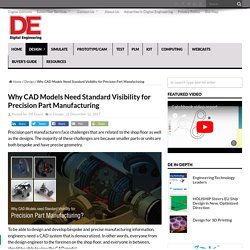
The majority of these challenges are because smaller parts or units are both bespoke and have precise geometry. To be able to design and develop bespoke and precise manufacturing information, engineers need a CAD system that is democratized. In other words, everyone from the design engineer to the foremen on the shop floor, and everyone in between, should be able to view the CAD model. Rapid Prototyping: In-House or Outsourcing? A CFD Approach for Design and Development in Oil & Gas Industry. Nov 28, 2016 -- Engineers most often rely on analytical modeling for engineering design and analysis performed using equations to obtain solution for a problem in consideration.
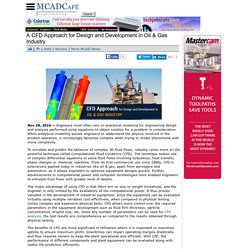
While analytical modeling assists engineers to understand the physics involved in the product operation, it increasingly becomes complex when trying to model phenomena with more complexity. To simulate and predict the behavior of complex 3D fluid flows, industry relies more on the powerful technique called Computational Fluid Dynamics (CFD). The technique makes use of complex differential equations to solve fluid flows involving turbulence, heat transfer, phase changes or chemical reactions. From its first commercial use since 1980s, CFD is extensively applied today in industries like oil & gas, apart from aerospace and automotive, as it allows engineers to optimize equipment designs quickly.
Vital applications of CFD that can help in keeping the plant efficient and functioning: Why SolidWorks Over Other CAD Tools? Product Development Posted by Kashyap Vyas on November 23rd, 2016 Globally, manufacturers of consumer products, industrial equipment, automotive parts and construction equipment rely on SolidWorks intuitive CAD modeling and virtual prototyping capabilities.
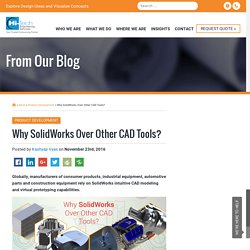
From conceptual modeling, 2D drawings and detailed 3D modeling to design automation, animation and manufacturing documentation, SolidWorks is indeed the first choice of design engineers across the globe. While some manufacturers have their own in-house resources, others prefer to hire SolidWorks certified drafting and modeling professionals, to meet the product development requirements. Either ways, SolidWorks still holds a major share in the CAD market. Challenges for the Digital Twin concept. Industry 4.0, often known as the Internet of Things (IoT), is supposed to help the manufacturing landscape undergo a massive overhaul to improve revenues, optimize worker productivity and increase operational agility to meet demanding market conditions.
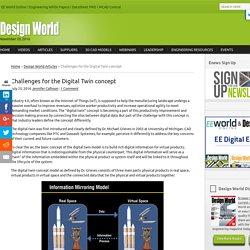
The “digital twin” concept is becoming a part of this productivity improvement and decision making process by connecting the silos between digital data. But part of the challenge with this concept is that industry leaders define the concept differently. The digital twin was first introduced and clearly defined by Dr. Utilize CFD for Wind Load Estimation on Offshore Platforms. Offshore platforms are designed considering the effects of wind loads on the structure, to ensure its safety and reliability.
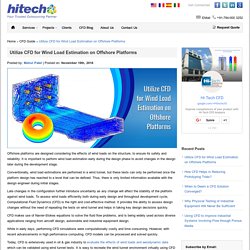
It is important to perform wind load estimation early during the design phase to avoid changes in the design later during the development stage. Conventionally, wind load estimations are performed in a wind tunnel, but these tests can only be performed once the platform design has reached to a level that can be defined. Thus, there is only limited information available with the design engineer during initial stages. Late changes in the configuration further introduce uncertainty as any change will affect the stability of the platform against wind loads.
Case Study: Design Automation for Retail Furniture Products Manufacturing. The Objective Improving the engineering, prototyping and manufacturing lead time for furniture designed for retail stores and expedite the delivery to customers. Challenges: Hi-Tech Partners with DriveWorks to Configure & Automate Product Designs for Manufacturers. »News»Product Development» Hi-Tech Partners with DriveWorks to Configure & Automate Product Designs for Manufacturers Product Development Posted by Kashyap Vyas on November 24th, 2016 In our pursuit to be one of the leading design support solution providers to manufacturers globally, we at Hi-Tech joined hands with DriveWorks, the leading design configuration and automation tool company.
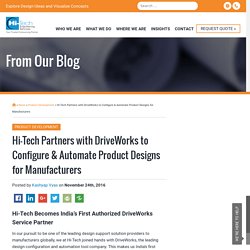
Shop Drawings; Benefits to Construction & Product Manufacturing Mechanical Design Projects. Posted by Nikunj Patel on August 1st, 2016 Coordinated MEP shop drawings for sheet metal ductwork, piping, plumbing, fire protection, and electrical, have attained the position of crucial aspects in the manufacturing and construction industry.
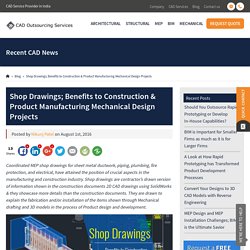
Shop drawings are contractor’s drawn version of information shown in the construction documents 2D CAD drawings using SolidWorks & they showcase more details than the construction documents. They are drawn to explain the fabrication and/or installation of the items shown through Mechanical drafting and 3D models in the process of Product design and development. Let’s make it simpler to understand as, the set of sketches and CAD design & drawings, prepared well in advance to the creation of different types of devices, and are known as Shop Drawings. Best Sheet Metal Drawing & Design Services. Drafting and modeling for sheet metal design is far more different and complex when compared to design development for solid objects.
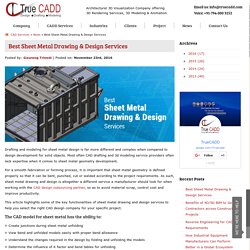
Most often CAD drafting and 3d modeling service providers often lack expertise when it comes to sheet metal geometry development. For a smooth fabrication or forming process, it is important that sheet metal geometry is defined properly so that it can be bent, punched, cut or welded according to the project requirements. Why use SolidWorks over other CAD Tools? 4 Reasons to Use Design Simulations to Improve Equipment Fabrication. Design simulations are increasingly becoming important in real-world applications. Be it about obtaining a driver’s license or learning to fly an aircraft, simulators are used in diverse business settings for different purposes.
Through simulation, outcomes can be predicted mathematically, so that risks can be assessed, products can be improved and failures can be avoided before even performing physical tests. To improve the equipment fabrication, design simulations are extremely useful in improving the outcomes. 20 Reasons to Use Finite Element Analysis for Product Design & Development. Finite Element Analysis (FEA) has brought numerous opportunities for product design engineers and manufacturers, and is now an integral part of product development process in industries like automotive, biomedical, aerospace, industrial equipment and heavy engineering.
It fundamentally consists of three main phases: pre-processing, solution and post processing. Following are the steps involved in performing an analysis using finite element method: Importing or developing a CAD geometry of the product for the purpose of analysisSelecting the element type (1D, 2D or 3D), depending on the simulation requirementsGenerating mesh for the model with the selected element typeMesh sensitivity and validation to rectify errors and refine the mesh qualityChoosing the type of analysis, e.g. static, dynamic, thermal or coupledApply boundary conditions like loads, moments, temperature, etc.Perform the simulationPost-processing to extract results. CAD Modeling and Manufacturing Drawings for Hollow Metal Doors & Windows. How Industrial Equipment Manufacturer Can Bring Products to Market Faster Using SOLIDWORKS.
Posted by Kashyap Vyas on November 5th, 2016 Industrial equipment manufacturers are often strained to meet customer requirements on time, and deliver functioning equipment to the customers. Manufacturers need the right technology tools that can integrate the product development processes seamlessly and enable them to reduce scrap, rework and cost, while maintaining the safety and reliability of the designed equipment. SOLIDWORKS is one such integrated product development tool that can assist design engineers to connect the silos in the development process and accelerate the time to market the product.
Being the most widely utilized design tool across the globe, SOLIDWORKS assists engineers across each and every step of the product development right from concept through fabrication. Bring Products to Market Faster with 3D Solid Modeling. Oct 31, 2016 -- The use of 3D solid modeling and visualization tools is very much common today by design engineers to clearly understand the design intent of the product they have conceptualized and sent it for actual production. These 3D models that represent the physical object are developed using points in a 3D space which are connected through geometric entities like triangles, lines or curved surfaces. 3D models are useful to communicate design information to suppliers and manufacturers, and enable them to develop products with accuracy.
However, these tools are often underutilized by designers. 3D models can be utilized to study the structural integrity of the design right from the early stages. This will enable creating accurate prototype which can be turned into a production part easily. Representing a 3D Model. CADD Services Outsourcing: Are You Choosing the Right 3D Printing Technology for Your Product? Sheet Metal Design; These 7 Tips Will Improve Its Strength. Being lightweight, non-corrosive, conducive and strong, sheet metal finds myriad of applications in almost every industry.
How Industrial Equipment Manufacturers Can Perform Better in a Global Ecosystem. Industrial equipment manufacturers face extreme challenges in differentiating themselves, as the complexity and competitiveness is on a rise with spreading global ecosystem. Rapid Prototyping Using Plastics for Lighting Applications Saves Time and Money.
Design for Manufacturability (DFM) for Product Design Saves Time and Money. Posted by Kashyap Vyas on October 5th, 2016. Taking a Leap Forward in Reverse Engineering. When you picture the term reverse engineering, you will often see a team of engineers measuring the physical part to record the dimensions, so that, the same part can be re-created with identical features. While this picture is still relevant today, the reverse engineering practice has grown into a more sophisticated and a complex process. With growing complexity in part geometry, data collection systems and measurement methods, there is a need of processes to handle this data.
The old method of measuring dimensions with calipers cannot capture complex details like curvature, shapes and contours. And as such, scanning systems are essential to accurately capture the geometry details. Convert Your Designs to 3D CAD Models with Reverse Engineering. Email. How Reverse Engineering is Driving the 3D Scanning Market? – Medium.
There is a rising adoption of 3D scanning systems for quality control, rapid prototyping and reverse engineering. A recent research by Global Market Insights projected that the 3D scanning market is set to exceed USD 6 billion by 2022, growing at a CAGR of 11.5%. The growth expectancy is primarily due to the growing need of developing accurate design information quickly, to meet the growing market demands. The 3D scanning market size in Latin America was valued over USD 250 million in 2014, which is estimated to cross 750 million by 2022, with a CAGR of over 13%. Forget DFM And DFA, Think DFAM – Design For Additive Manufacturing. Posted by Prahlad Parmar on October 3rd, 2016. Utilizing CAD from Concept through Production.
PRODUCTION READY SHEET METAL DESIGN USING SOLIDWORKS. 5 Reasons to Incorporate Value Engineering in Product Development Cycle. How Offshore Outsourcing Affects Customer Satisfaction? How Do You Know Your Company Requires an ERP System? Self-Healing Concrete Mends Cracks on Its Own. W3C Pronounces HTML5 Standard Complete, Changing Web Development Forever.
Experts Forecast Global SaaS based ERP Software Market to Grow at a CAGR Of 13.8% On Premise SharePoint Server 2016 in the Offing…!!! What’s in store for all??? Not Using Business Intelligence…! Are You Really Intelligent Enough…??? Business Intelligence and Analytics - Trends 2015. Business Intelligence (BI); An Absolute Disaster…!!! - IT Blogs - MyTechLogy. Get 2015 Business Coverage Now: Top 10 Business Trends to Dominate Success. The 6 second Resume. Trends That Will Have an Impact on BIM Adoption In 2015. 5 Transformational Trends for Business in 2015. Mobility in Retail Fuelling a Highly Dynamic and Competitive Online Marketplace. Build an effective customer relationship with data mining in retail industry. Business intelligence meets Big Data To Give You Big Business Insights.
Elite Hackers Are at Work – Is Your Organization Safe from Massive Cyber Attack??? Sony Pictures were NOT. Micro Moments to Replace Isolated Apps. How to Turn Mobility Challenges into Opportunities? Are You Suffering From A Well Frog’s View? Next-Gen Analytics Are Transforming Retail Management Systems digitally through MS Dynamics AX; but Is Your Company Really Transforming Digitally? Design Services for Tanks & Pressure Vessels Complying to ASME Standards. How Outsourcing Rapid Prototyping Projects Can Still Be Beneficial. Why Create 2D CAD Drawings When You Have 3D CAD Models. AutoCAD Mechanical 2D Drawings; not going obsolete in 3D World. Retail Shopfitters Help Your Store Attract More Customers. How Furniture Manufacturers Can Turn Their Engineering-to-Order. Design Sheet Metal Roofs that meets Standards, Building Modules & Aesthetics.
Adopting Modular Design Approach to Survive the Squeezing. Fuel Efficiency – Core Focus of Aerodynamics - The Engineering Exchange. Machine Design Procedure: an Engineer’s Guide to Mechanical Design and Development. Outsource Mechanical CAD Design Services to Indian company for Optimum ROI. 5 Points Every Analyst Should Follow to Make Design Development through FEA Meaningful - Blog. Incorporating Engineering Ethics for the Credibility of FEA Results. 5 Tips to Incorporate Simulation Driven Design for Your Next Product Design Project. Acoustic Analysis Using Energy Modeling – Building Design For Occupant Comfort.
How to do Energy Analysis of Existing Buildings with Rapid Energy Modeling? Building Energy Efficient Products for a Better Tomorrow Using CFD. A Guide to Hire the Right CFD Consulting Company. 10 Mistakes that makes you pay more for Finite Element Analysis (FEA) Finite Element Analysis for Plastics and Rubber Components. Outsourcing: A Profitable Decision for the Automotive Industry. How to Efficiently Manage Assembly Modeling Process in Solidworks. Benefits of Using Rapid Prototyping Technique for Jigs and Fixtures. Comparing Sheet Metal Drawings Vs Casting, Explaining Flow and Control. Sheet Metal Designing to Forming to Cutting floor, BIM Strengthens the Fabrication Process. 10 HVAC Components, Sheet Metal Designers are Cautious with in Ductwork Projects.
3 Products We Design, That Every HVAC Sheet Metal Fabricator Should Use. Why Material Models Matter for Metal Forming Simulation? Allow Product Engineers to Perform Geometry based Forming Checks to Reduce Sheet Metal Forming Issues. Sheet Metal Design Reuse, SolidWorks PDM Benefits Building Product Manufacturers. Best Practices to Strengthen Your Sheet Metal Design. Sheet Metal Bending Is A Non-Subtractive Fabrication Process. The Secrets Of A Successful Mechanical Product Design. Optimizing Cost Estimation Capabilities: A Key to Successful Project Outcomes for EPCs. Building Frugal Products Using CAE Tools for Emerging Markets.
Supporting Sheet Metal Product Design by Shifting from an Outsourcing to Productivity Partner. Removing Unnecessary Conservatism from Product Designs. Compressed Air: New Battery For Our Bright Future. Is Generative Design the Future of CAD? The Need for Next Generation Collaboration Tools for True Digital Transformation. Cloud CAD: Our Make-believe Evolution. 3D Printing and its ambitions in Oil and Gas. Developing Products for Future Success. Don’t Follow Leaders; Build Your Own Digital Strategy that’s Right for You. CAD Collaboration Tools: Why You Need Them and What Benefits Can You Expect? Enhancing Your Product’s Technical Communication with SolidWorks Composer. CAD Standardization To Deal With Multi-CAD Problems. 3 Things You Probably Didn’t Knew About Rapid Prototyping.